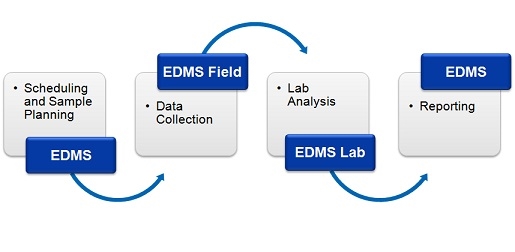Your single point of reference for all your Geotechnical Inquiries
EDMS
EDMS is used to improve and standardize environmental data collection, management, and reporting in an efficient and cost-effective manner. This is accomplished by implementing a documented, auditable process for the collection, storage, and reporting of environmental field data. Throughout this process all stages of the sampling and analysis are tracked and notifications can be sent via email or SMS (text message). Notifications for non-compliance events and sample exceedences can be automatically sent by the system.
This process can be divided into four stages:.
1. Scheduling and Sample Planning
The first stage in any environmental field program is the scheduling and planning of sampling events. EDMS allows project managers to design, delegate, and monitor sampling events. Sampling events can be either singular or re-occurring. Prior to data collection, sampling stations can be specified. These sample stations include information on station location and construction, sampling defaults and methodology, lab analyses required, required equipment and personnel. Sample labels with barcodes and a Chain of Custody (COC) can be printed from the stations to be used in data collection and lab submittal.
2. Data Collection
When a sampling event occurs all of the station information is inherited by the sample including sampling defaults, required lab analyses, and personnel. Detailed sample information can be recorded for each environmental media on a Windows laptop or tablet using EDMS Field or a field notebook (for later data entry). Sample photographs can also be included with the sample data. Sample data collected using EDMS Field can be uploaded to the main database remotely as an Electronic Data Interchange (EDI) file. The remote uploading of data using an EDI file provides for faster more comprehensive data reporting and reduces the possibility of transcription errors.
3. Lab Analysis
Samples submitted for lab analysis are tracked during shipping, receiving, lab analysis, and reporting process. This tracking is reported on by EDMS and EDMS Lab (free lab reporting software provided by GAEA). Analytical labs using EDMS Lab can upload analysis results to the main database automatically as an EDI file. The electronic reporting of lab data reduces the effort and possibly of errors of manual data entry. A Certificate of Analysis (COA) can be included in the EDI file and a copy stored in the main database.
4. Reporting
Sample and lab analysis results can be collated and reported on in a variety of tables and graphs. These tables and graphs can be easily customized to meet internal and external needs. In addition, EDMS data is fully integrated and available for use by other modules within StrataExplorer. Sample and lab analysis data can be viewed and used in the WinLoG, WinFence, SE-GIS, and SE-Map modules.
Canada











